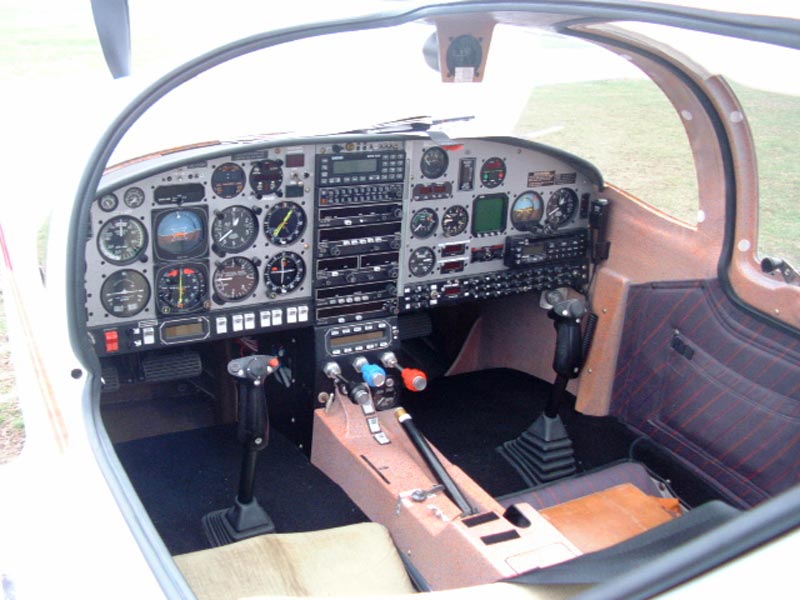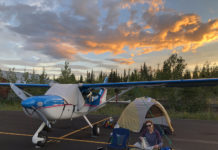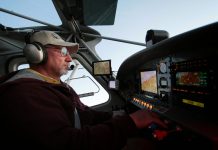In the Beginning, the Dream…
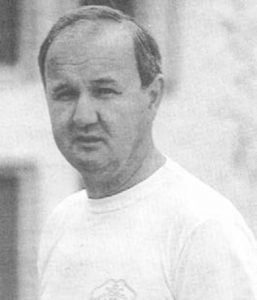
Since I was a child, I had the dream of building an airplane and flying it around the world. Now, at the age of 49, I have fulfilled this dream, but there was much to be done along the way . . .
- 1966 I learned to fly gliders.
- 1973 I got my private pilot’s license.
- 1975 I received my glider instructor’s rating.
- 1976 I began my current profession— teaching carpentry in a vocational school.
- 1979 I received my private pilot instructor’s rating.
- 1982 I started work on a new home for my family and me (with a big garage for constructing my airplane)!
- 1983 I got a commercial license with an instrument rating.
- 1987 I made my first transatlantic crossing, ferrying a Mooney 231 from the United States to Europe.
- 1989 I finished my house and began work on my Glasair II-S RG.
- 1994 I flew in the World Precision Flying Championship and won first place in the spot landing competition.
- 1995 After approximately 5,000 working hours, I finished my Glasair and immediately began preparing for my world flight. I fabricated a big auxiliary fuel tank fitted to the co-pilot’s seat with a total capacity of 260 liters (42 gallons). Together with the normal tanks, this gave me the ability to fly approximately 16 hours at 60% power at an altitude of 10,000 feet with a TAS of 174 knots and a range of nearly 2,700 nautical miles. A second GPS completed the full IFR panel.

December 1995 I began my route planning, sending lots of faxes around the world. My first plan was to fly west, but after consulting a meteorologist, I changed to an eastward route. The route I chose would send me first to Australia, then via Indonesia to the Philippines and Hong Kong, then on to Japan, and from there via the Kuril Islands and Kamchatka Peninsula of Russia to Nome, Alaska. From Nome, the plan was to fly down the west coast of Canada to the Glasair factory, and then across the U.S., the Atlantic and back home.
However, three weeks before takeoff I was informed by the Russian Ministry of Transportation that I would not be allowed to fly over Russian territory without a Russian navigator due to the need for Russian language. Therefore, I was forced to chart a new route straight across the Pacific Ocean. Originally, I had hoped to avoid such a lot of water with only one engine!
Karachi’s Revenge
August 15, 1996 My dream comes true as 1 start my ’round-the-world journey.
Takeoff from Wels, Austria, was at 6:11, for my first leg via Hungary, Yugoslavia, Greece, Crete, and across the Mediterranean Sea to Luxor, Egypt.
Ten hours, twenty minutes flying time.
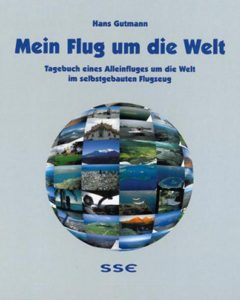
After takeoff, I was very surprised by the instability of my plane. It was the very first time I had flown with an overload of about 350 pounds and a CG aft of the normal limit. My S-Tec 65 autopilot was not able to fly the plane for the first four hours. After that time, the weight and balance became normal, and the autopilot system worked. After about one hour, I came out of the clouds over Lake Balaton in Hungary. From there to India I had very good weather.
During a one-day stopover, I went sightseeing to visit all the historic culture in Luxor. My plane was guarded on the airfield by a gun-toting soldier. The fee for that service was $15 per day.
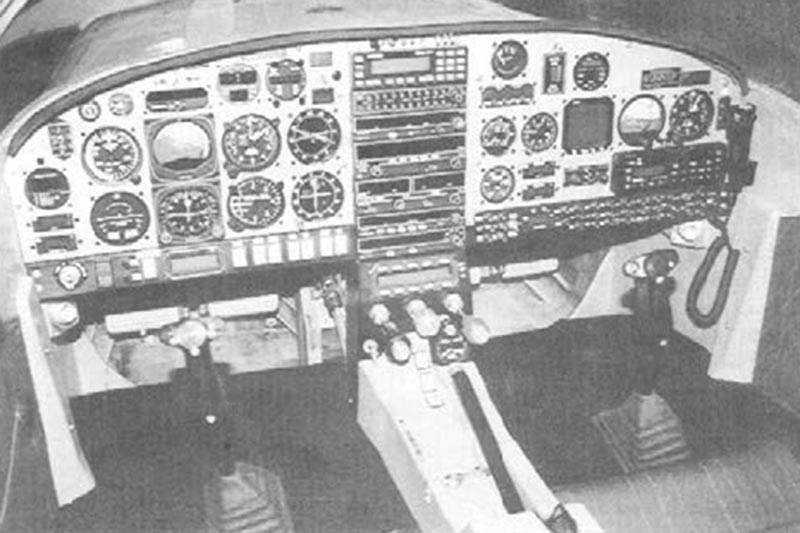
August 17 The second leg: Luxor, Red Sea, Saudi Arabia, Bahrain, Persian Gulf, Qatar, Muscat, Oman. Flight time was nine hours and fifty minutes. When I took off from Luxor at 6:30, the temperature on the ground was already 26° C (84° F). Overloaded again, a hot step climb brought me to my cruising altitude of 10,000 feet.
I made a one-day stop at Seeb/Muscat International Airport to check the airplane and change the oil. The temperature at sea level was 45° C (113° F) with very high humidity. Refueling, 1 paid $372 for fifty-seven gallons. For landing, parking and handling, I paid $310—this was the most expensive stop of my journey.
August 19 The third leg. I had planned to fly to Ahmedabad, India, but over the Pakistani coastline, I was told that my permission to enter Indian airspace had been canceled. I requested to land at the Karachi, Pakistan, airport without permission. After landing, my first act was to pay $200 for “handling,” but following this formality, there were no problems. I was invited to a lunch with the friendly people of the handling agency at their office. Unfortunately, this turned out not to have been a good idea, as I had diarrhea from that time until arriving in Australia.
August 20 Working with the handling agency, I re-received my permission to enter Indian airspace and land at Ahmedabad. I departed IFR and climbed out on top to FL95. On arrival, the bureaucratic ceremony was most impressive. I filed packages of paper to enter Indian territory.
August 21 Ahmedabad-Calcutta, a five-hour and ten-minute leg. The last hour of the flight I fought heavy monsoon thunderstorms. This was the first time I had seen lightning during the day in clouds with heavy rain and turbulence. But, I made a safe ILS approach at Calcutta, a town of approximately 12 million people. To leave the airport took four hours of bureaucratic paperwork with always friendly guys.
August 22 Planned leg to Bangkok, Thailand. I was at the airfield at 6:30, but had to endure four hours of bureaucratic difficulties during checkout. At 10:30, I tried to arrange refueling, but this was not possible because of a broken fuel pump. Finally, the fueling got underway, but then I was delayed an additional one-and-a-half hours due to heavy rain. It was too late for takeoff on that day. Back to the airport hotel at 4:30 p.m.
August 23 At the airport at 5:30, at my Glasair at 9:00—bureaucracy again!
Clearance received, I taxied out to the runway, but while taxiing, I noticed no battery load. Back to parking to check the alternator belt, which seemed OK.
The electrical connections all looked OK, too. It started to rain (at 38° C (100° F)), I had painful diarrhea, and I had no idea where I should begin my search for the electrical trouble.
I had installed the LR-2 linear voltage regulator. In the side of that regulator is a small plugged opening through which to adjust the voltage. As I removed the plug, water ran out. The very high humidity had caused condensation inside the regulator. After removing it, drying it with my handkerchief and remounting it, it worked. This job was done during a heavy monsoon rain on the large apron of the Calcutta airport—me and my plane all alone. This was the low point of my ’round-the-world flight!
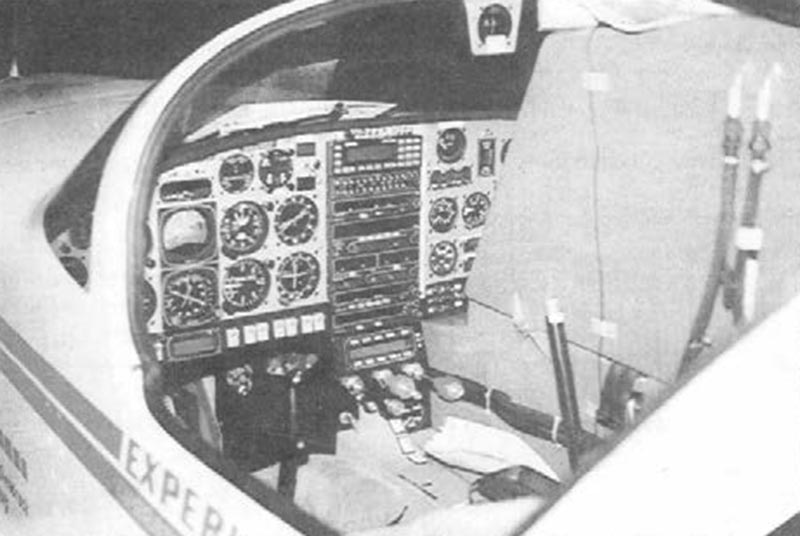
August 24 I arrived at the airport at 4:30 to be early enough for the next leg to Bangkok. The customs officers were sleeping in the departure hall. They had had a late dinner on the floor where they slept. Only a small lamp was on in the dark hall as I entered, and 1 saw some rats having a good meal of the remains of the late-night dinner between the sleeping people.
After I woke the officers up, I got a warm welcome; by now—the third time I had negotiated the bureaucracy—all the officers knew me. At 8:00 I had finished all the paperwork for the flight to Bangkok. Takeoff was at 8:31, with thunderstorms forecast en route. Over Burmese territory 1 wanted to divert from the airway due to very large buildups, but at FL110,1 could make no contact with Rangoon. I requested help with a relay, and a Lauda Air jet helped me out. Rangoon cleared me to avoid the biggest buildups. Four hours and fifty-two minutes after takeoff, I landed at Bangkok airport.
August 26 Bangkok to Singapore. IFR departure and climb, but a smooth flight on top until I was fifty miles from Seletar airport, when I encountered heavy thunderstorms again. To avoid them, I descended VFR to 500 feet AGL. Singapore Approach could not receive my transponder signal, and so I had to report my position every minute.
Visibility during the last thirty miles of that flight was sometimes below one mile. I finally located the runway when I was on short final.
I stopped over two nights in Singapore, needing to do another inspection and oil change. One oil line was oily, so I changed the whole hose assembly. The 2″ air intake tube also had a leak, so I changed it as well. Many thanks to Mr. Tham Wie Min from ST Aerospace
Engineering, a helicopter assembly and maintenance company, where I did my maintenance. During that inspection, I also cleaned the fuel pump for the auxiliary tank. Because I was still ill (since Karachi 1 had only drunk water and eaten some salt), I forgot to tighten a fitting on the pump. The entire stay at Singapore was rainy—monsoon time.
August 28 Another IFR departure, bound for Bali, Indonesia. After takeoff, as I entered the clouds, I switched on the aux fuel pump only to see fuel leaking out of the untightened fitting.
Fortunately, I was able to grab the right wrench from the baggage compartment to tighten the fitting and get the leak stopped—all in the clouds without an autopilot. This part of the departure was not the best, I think! Above the Indonesian capital, Djakarta, I came out of the clouds into VMC and enjoyed beautiful weather all the way to Hawaii.
During a one-day stop on the island of Bali, I relaxed, enjoyed the very nice landscape and ate my first soup since Ahmedabad.
August 30 A 6.5-hour leg to Darwin, Australia.
Beautiful weather. During my approach to Darwin, I was ordered to stay in the cockpit after arriving at my parking position. Because of the heat, I opened the canopy. Two guys approached my aircraft and told me to close it. They handed me a spray can and explained that I was to fumigate my cabin against insects. Reading the instructions on the back of the can, I learned that two of those cans were enough to fumigate a Boeing 747. Thank God they h?”ded me a can that was only half full! After that procedure, I was ready to enter Australian territory. I flew on to Tindal, one-hour’s flight south from Darwin.
Because I was two days behind schedule, I decided not to fly my planned route through central Australia via Ayers Rock and Sydney to Brisbane, but rather to fly straight to MacCay and then on to Brisbane.
August 31 A smooth six-hour, thirtysixminute flight across the Northern Territories to MacCay, landing shortly before sunset.
September 1 A clear, windy day. Three hours and thirty-one minutes to landing at Archerfield, Brisbane, where the quartering winds were blowing 35^5 knots. I spent two days at Southern Skies Aviation (thank you, Steve Taddeucci, for your support) to perform a very careful inspection and oil change before flying over the Pacific Ocean.
Across the Blue Pacific
September 3 A ten-minute flight to Brisbane airport to clear customs and file a flight plan. Then a smooth, four-hour and twenty-two minute flight to Tontouta, New Caledonia. During the approach I was asked what kind of airplane I was flying and if I was some kind of VIP. The officers all got a big surprise when they saw me and my small plane on the ground!
September 4 A rainy day. I wrote postcards and relaxed.
September 5 Four hours and forty minutes to Nausori, Fiji. A very enjoyable flight, but 1 was still two days behind schedule, so only an overnight stop.
September 6 Four hours and twenty minutes to Pago Pago, American Samoa.
I saw very beautiful islands along my route and enjoyed a very smooth flight.
September 7 To Cassidy International, Christmas Island. After departure I received instructions via a VHP frequency to squawk an HF frequency.
I couldn’t confirm that because I had no HF. The controller advised me to return to Pago Pago, but I didn’t understand that advice. As I arrived at Cassidy International, I had no contact with the “tower” and no contact with the Christmas NDB. I was proceeding with GPS navigation only. After landing at Cassidy, I found I was entirely alone.
After forty-five minutes of waiting, a controller finally arrived at the airfield, saying he had received no flight plan.
Because of the non-existent infrastructure, I phoned a friend of mine in Austria to fax me weather information and make my flight plan for the next seven-hour leg. It was there I had the loneliest feeling of my life.
September 8 After refueling from a barrel, I took off for Hilo, Hawaii. The forecast I had gotten from Austria was good. Again, I had no contact with any station, not even on 121.5. One hundred fifty nautical miles from Hilo, a big wall of thunderstorms appeared in front of me. I changed my altitude from 11,000 feet to 500 feet to reach the coastline, and then followed it inbound to Hilo. Sometimes, due to a very low ceiling and visibility below one mile, 1 flew below 100 feet AGL. I think this was the most difficult part of my trip.
I had planned on a relaxing four-day stay in Hawaii, but it rained all four days, so this stop was not restful.
September 13 I tried to file my flight plan over the phone, but as I was spelling the call sign, the officer ordered me to come to the office personally. After arriving, I received some information about American regulations. It was not possible to fly over open sea without an HF transmitter for making position reports, and I could count on big trouble if I violated this regulation.
I contacted John Carlson, a professional ferry pilot with lots of experience at ferrying small airplanes, and he agreed to ferry my plane with his own HF radio.
The cost was $2,000. After he installed his HF radio, takeoff for the longest leg of the trip was at sunrise on September 16. He flew the 2,025 nautical mile trip to Hayward, California, in thirteen hours, forty-two minutes. My luggage and I were flown by airline.
Homeward Bound
September 17 I met John at the Hayward airport. He told me the Glasair was running very well. I was very happy to get my plane back again. At Hayward, I got to know Glasair builder Earl Hiebler. Earl built his II FT with a 260 h.p. 6-cylinder engine instead of my 4-cylinder 180 h.p. engine. I was very impressed with the speed of his airplane; during a flight we took together, he dove in at Hayward for an overshoot and we reached 290 knots indicated! Since that flight, I’ve been very confident in the strength of my aircraft.
Earl provided me accommodations at his house for the next two days and helped me make the 100-hour inspection.
(Thank you very much to Jean Montgomery and Earl Hiebler for that warm welcome—I hope our arrangement for a meeting at my home in Austria comes true.)
September 20 Earl recommended I stop at Sedona, Arizona, on my flight to Texas. An unforgettably smooth flight in cloudless weather over Las Vegas and along the edge of the Grand Canyon brought me to Sedona. After landing, I couldn’t believe my eyes—on the apron was parked Jiirg Sommerauer’s Glasair.
Jiirg’s Glasair was the first I had ever seen when it was under construction in Zurich, before I had started working on my plane.
I was able to find Jiirg’s phone number, and he came out to the airfield and invited me to his home. As we arrived there, we met Hans Schneider, another flying enthusiast who has flown his Cessna 150 all over Europe, Asia, Australia and America and has written a book entitled The Trip Is the Target. I read this book before my flight and was very glad to meet the author. As you can imagine, that evening was filled with lots of stories about our experiences. (Lots of thanks to you, Jiirg, and Hans for that wonderful evening—it felt like home.) September 21 Under the escort of Hans Schneider’s C-150, “Corbus,” and Jiirg Sommerauer’s Glasair I, “The Pink Baron,” I took off bound for Meacham Field in Fort Worth, Texas, where I met up with other members of the Austrian National Precision Flying Team. I was there until October 6 for training and ultimately competing in the World Precision Flying Championship. I was able to get second place in precision landing with a hired Cessna 150.
October 6 Takeoff from Meacham Field to be back home as planned on Saturday, October 12. A short stop for lunch in Muncie, Indiana, and a final landing that night in Williamsport, Pennsylvania, the cradle of my engine.
October 7 Short legs via Bangor, Maine, to Halifax, Nova Scotia. And a very thorough met briefing for the next day’s flight.
October 8 I had planned a leg to St. Johns, Newfoundland, but due to fog at St. Johns, landed at Gander, Newfoundland, instead. Another careful met briefing. A storm depression was moving quickly northeastward along the Newfoundland coast, and another low was laying over the North Atlantic, with a cold front across my planned route to the Azores.
October 9 After a restless night because of the weather, I decided in the morning to do the jump to the Azores.
Nine hours and thirty-five minutes later, I made a sunset landing at Ponta Delgada, Azores.
October 10 Five hours and twenty-two minutes to Lisbon, Portugal.
October 11 A short jump across the Pyrenees for landing at Le Puy, France for a safe last step back home according to schedule (to arrive in Wels at 3:00 p.m. on Saturday).
October 12 The final leg! Two hours and fifty-three minutes flight time, landing at 3:11 back home in Wels, Austria. Big celebration with family, friends and music at the airfield.

The Next One
I’m very happy to have safely completed my dream flight—167 flying hours, thirty legs, fifty-nine days and a lot of experiences behind me. A good plane, a healthy engine and GPS navigation made it possible. I experienced only friendly people around the world.
Now that I’m back home, I think you can count on some more Glasair and GlaStar orders. I’m working now on a GlaStar with my friend Jens Tetauer, and after his airplane is completed, I’m planning my next one—a Glasair III!
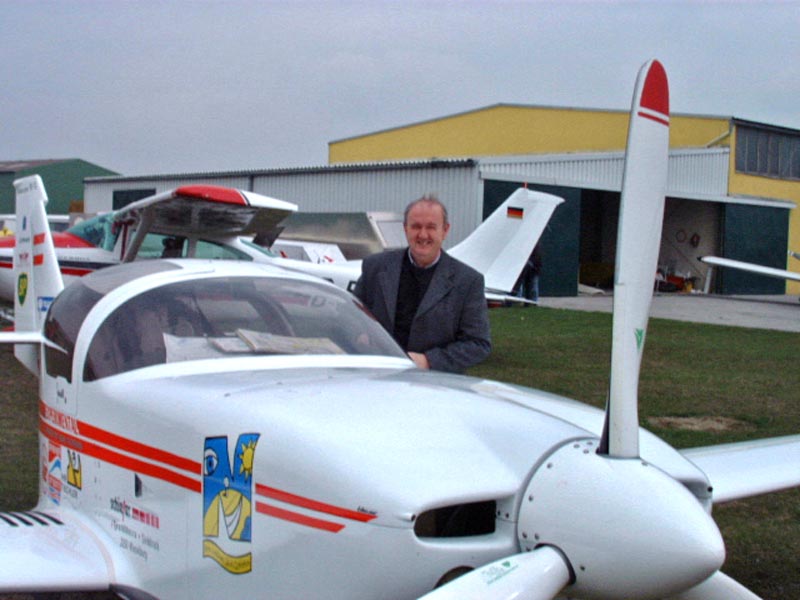
Editor’s note: This article was originally published in Stoddard-Hamilton News in 1997. Hans Gutmann passed away in 2011.

